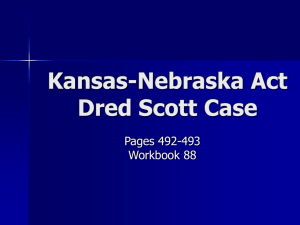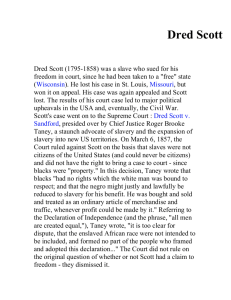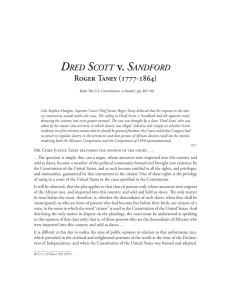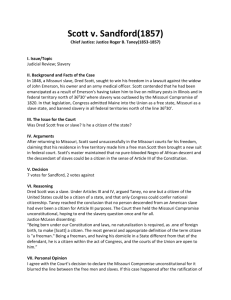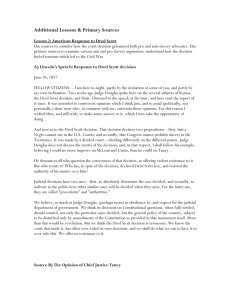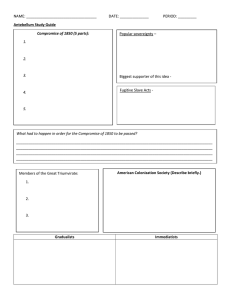Dred Scott v Sanford
advertisement
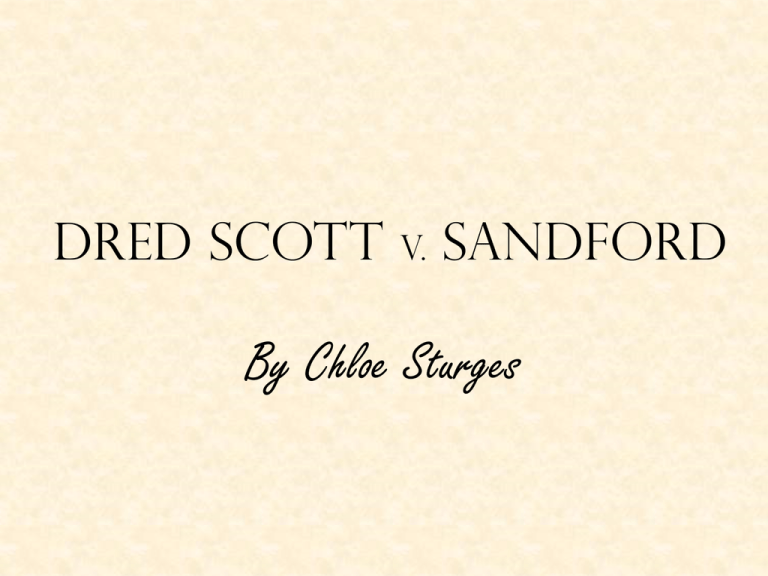
Dred Scott v. Sandford By Chloe Sturges Overview Dred Scott, a slave in the 1800s, was taken out of Missouri, a slave state, by his owner John Emerson (an army surgeon) to military bases in free territories Illinois and Wisconsin, and then taken back to Missouri after a few years. His owner died soon after their return, and Scott was passed to John Sanford. Scott believed he should be freed on grounds that he had lived in free territory and should therefore be emancipated. His case eventually came before the supreme court, led by Chief Justice Robert B. Taney, a slavery supporter. The Court ruled that persons descended from African slaves could not become citizens even if they were freed, and therefore were not entitled to protection under the constitution. The Court also ruled that the Missouri Compromise of 1820 was unconstitutional because Congress had no right to prohibit slavery, due to the fact that slaves were property and the Constitution protected the right to property. Details of ruling • Taney (writing for the majority) said Scott could not sue Sanford because he was not a U.S. citizen. • Court found that Scott was not a citizen because he was both a slave and of African descent • Taney believed slaves "had no rights which the white man was bound to respect" • President elect James Buchanan convinced Democratic justice Robert Grier to vote with the Southern majority on this ruling to make it seem like the decision wasn’t purely sectional in favor of the South • Taney ruled that the Missouri Compromise of 1820 was unconstitutional because slaves were property, or “chattel”, meaning Congress could not prohibit slavery in a territory because that would go against the Constitution’s protection of the right to property. • Made possible the expansion of slavery into the territories. Dred Scott • • • • • • • • • • Lived 1795-1858 Born a slave in Southampton County, VA 1834: taken by owner John Emerson to free territory Illinois and Wisconsin – then back to Missouri (slave state) about 12 years later During his time in free territory, Emerson allowed Scott to be married, an uncommon privilege for slaves at that time (Scott later had 2 children) Emerson died in 1843, upon their return to Missouri, and Scott, along with wife Harriet, were passed to the ownership of Emerson’s wife, Eliza Emerson. Dred Scott attempted to buy his freedom, but Emerson refused, so he sued Emerson for his freedom 1846 ( Scott and family were found free, but Emerson was granted a new trial set for 1848) Before the trial, Emerson moved to Massachusetts, transferring advocacy of the case to her brother, John Sanford This case went before the U.S. Supreme court March 6, 1857, in Dred Scott v. John Sandford (the Court misspelled Sanford’s name), after much debate, the Supreme Court ruled against Scott 7 to 2, with Chief Justice Roger B. Taney giving the majority opinion. a Short time after the trial was over, the sons of Peter Blow, Scott’s first owner, bought Scott and his family’s emancipation Robert B. Taney • • • • Lived from 1777–1864 5th Chief Justice of Supreme Court 1836-1864 Died on the day Maryland abolished slavery Replaced John Marshall as Chief Justice of Supreme Court • Emancipated all of his own slaves and gave them pensions when they became too old for work • Became very pro-slavery over time • Believed the Dred Scott decision would take the issue of slavery out of discussion and keep it from being debated anymore Taney’s ruling v Opposition • 2 justices (Justice Curtis and Justice McLean) dissented and contradicted Taney’s views, saying blacks were citizens in many Northern free territories so they were citizens of the U.S. • Also, in Constitution, only 3 sections actually mention slavery (sort of), and when the term slavery is implied, slaves are referred to as persons, not property. Who? Robert B. Taney Dred Scott Dred Scott’s wife, Harriet James Buchanan When & Where? (the arrows depict Dred Scott’s voyage from slave to free back to slave territory) St. Louis Misouri, location of early court proceedings Washington D.C., location of Supreme Court hearing Free territories Scott lived in What if things had gone differently? • The Decision caused many Northerners to fear that slavery would spread to the Western territories and maybe even to the Northern States eventually. This growing fear in the North was one of the contributing causes of the Civil War. • But What if the Supreme Court had ruled in favor of Dred Scott? Would there still have been a Civil War? • Would it have been sooner or later? • Noting that the 14th amendment specifically overruled the Dred Scott decision, granting citizenship to all persons born or naturalized in the United States, would the 13th and 14th amendments to the Constitution have been created after the Civil War? • Would Lincoln still have felt the need to issue the Emancipation Proclamation (immediate freedom of all slaves) at the start of the Civil War? • In summary, this decision had a profound impact on American History, but we will never know what might’ve been if that ruling had been different. Consequences of Decision • Dred Scott decision one of the major causes of the Panic of 1857, because people in west were afraid if slavery was opened to all western territory, railroad bond values would plummet • Caused a run on major New York banks • Fear of possible spread of slavery into the North was contributing factor in Civil War Once Dred Scott and his family were finally freed in 1858, they lived in St. Louis Missouri, where Scott was a local celebrity until his death only 18 months later. He died of tuberculosis in 1858. Roger Taney remained Chief Justice until after the Civil was began, although by that time he was hated by both the North and South, including president Lincoln. Sources Pictures • • • • • • • • http://www.lib.unc.edu/coursepages/hi st/images/DredScott.jpg http://media-2.web.britannica.com/ebmedia/34/66834-004-F337E210.jpg http://www.sos.mo.gov/archives/resou rces/africanamerican/scott/images/87 44-08.jpg http://www.iamthewitness.com/books/i mg/Roger.B.Taney.jpg http://mentalfloss.cachefly.net/wpcontent/uploads/2008/06/225pxRoger_Taney.jpg http://z.about.com/d/americanhistory/ 1/0/k/9/15_buchanan_1.jpg http://images.google.com/images ?hl=en&client=firefoxa&rls=org.mozilla:enUS:official&um=1&q=dollar+signs &sa=N&start=18&ndsp=18 http://www.slaveryinamerica.org/g eography/slavery_us_1860.jpg Information • • • • • http://www.answers.com/topic/dred-scott http://www.biographybase.com/biograph y/Taney_Roger_B.html http://en.wikipedia.org/wiki/Dred_Scott_v ._Sandford#Scott_v._Emerson http://www.apstudent.com/ushistory/sear ch.php Text book Primary Sources • • • • The United States Constitution www.USConstitution.net Scott v. Sandford – full text http://supreme.justia.com/us/60/393/cas e.html
